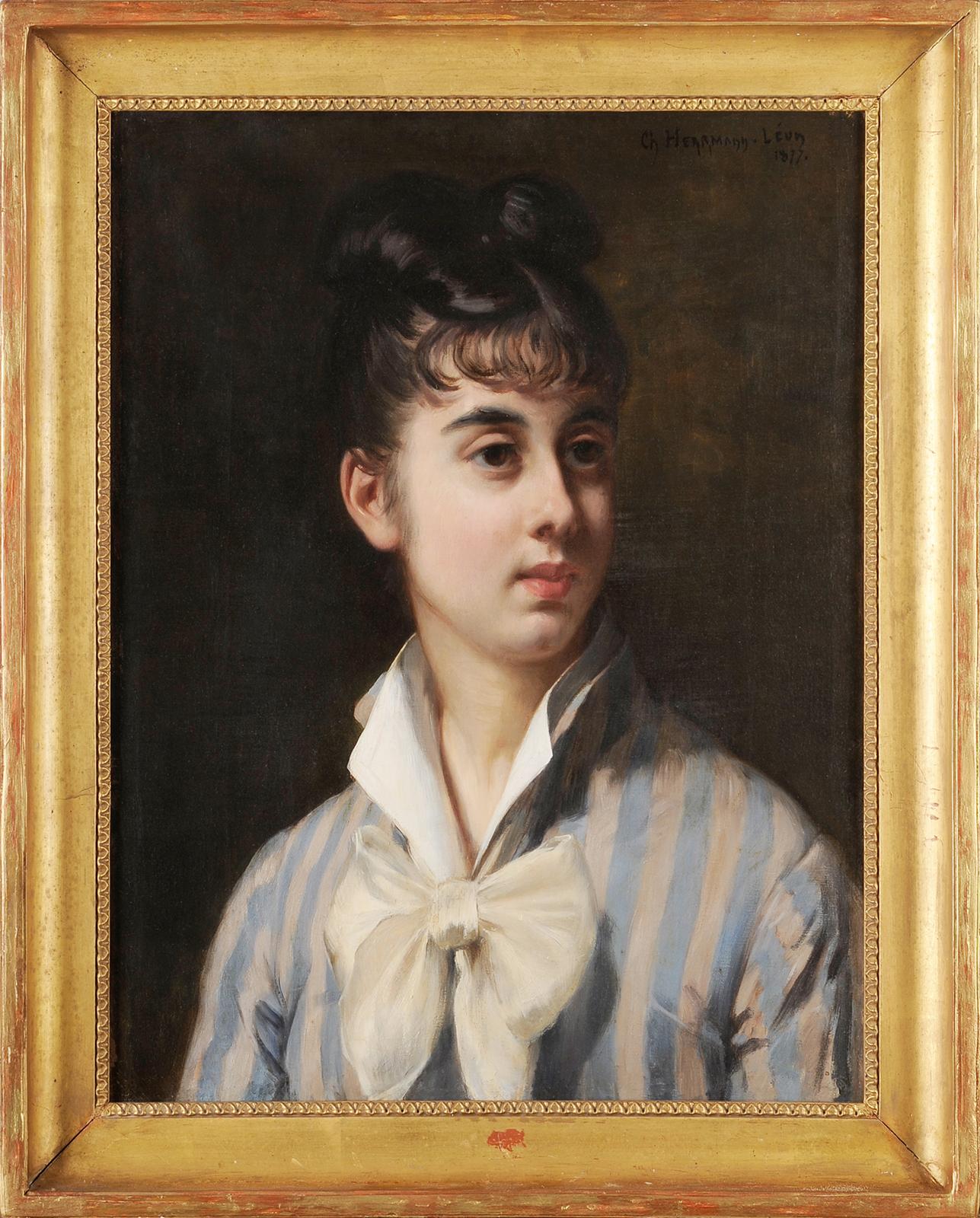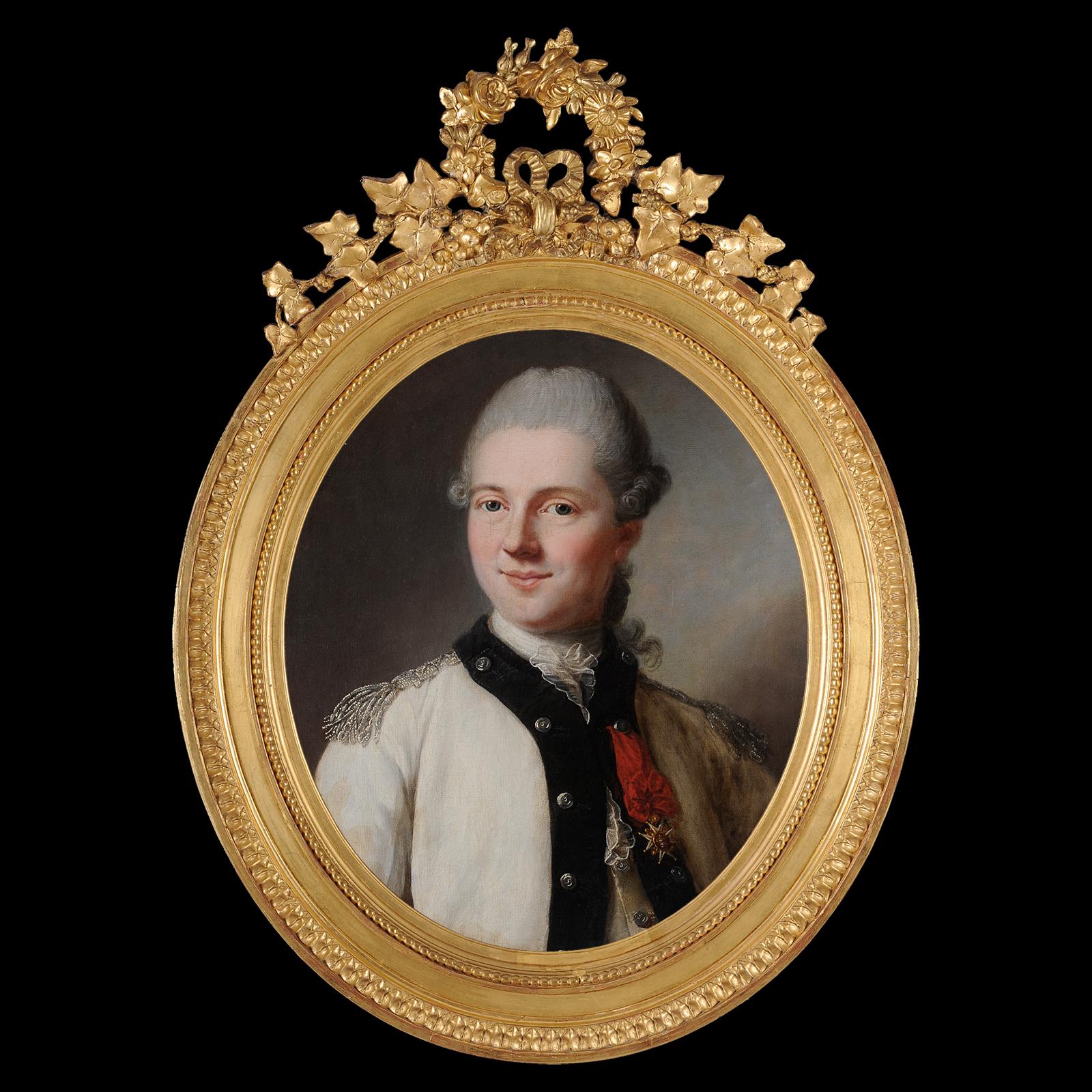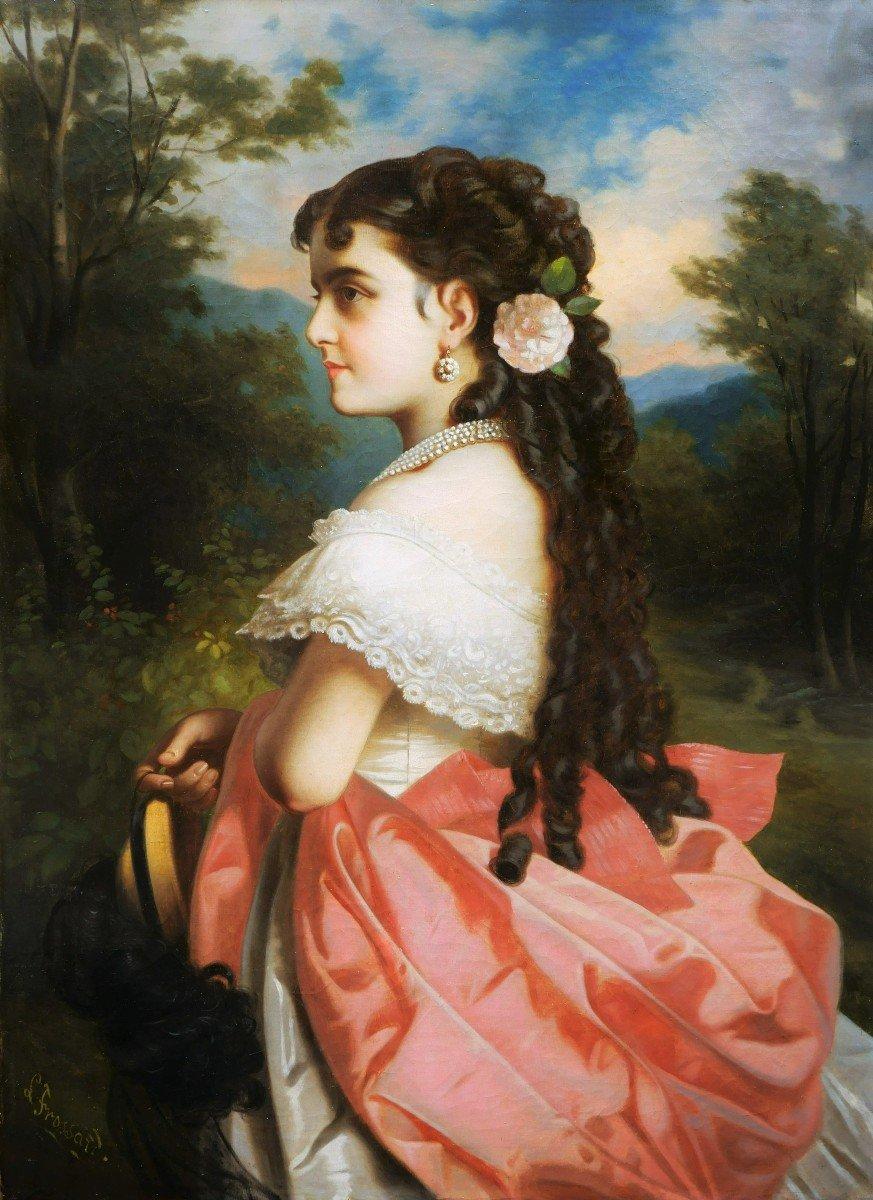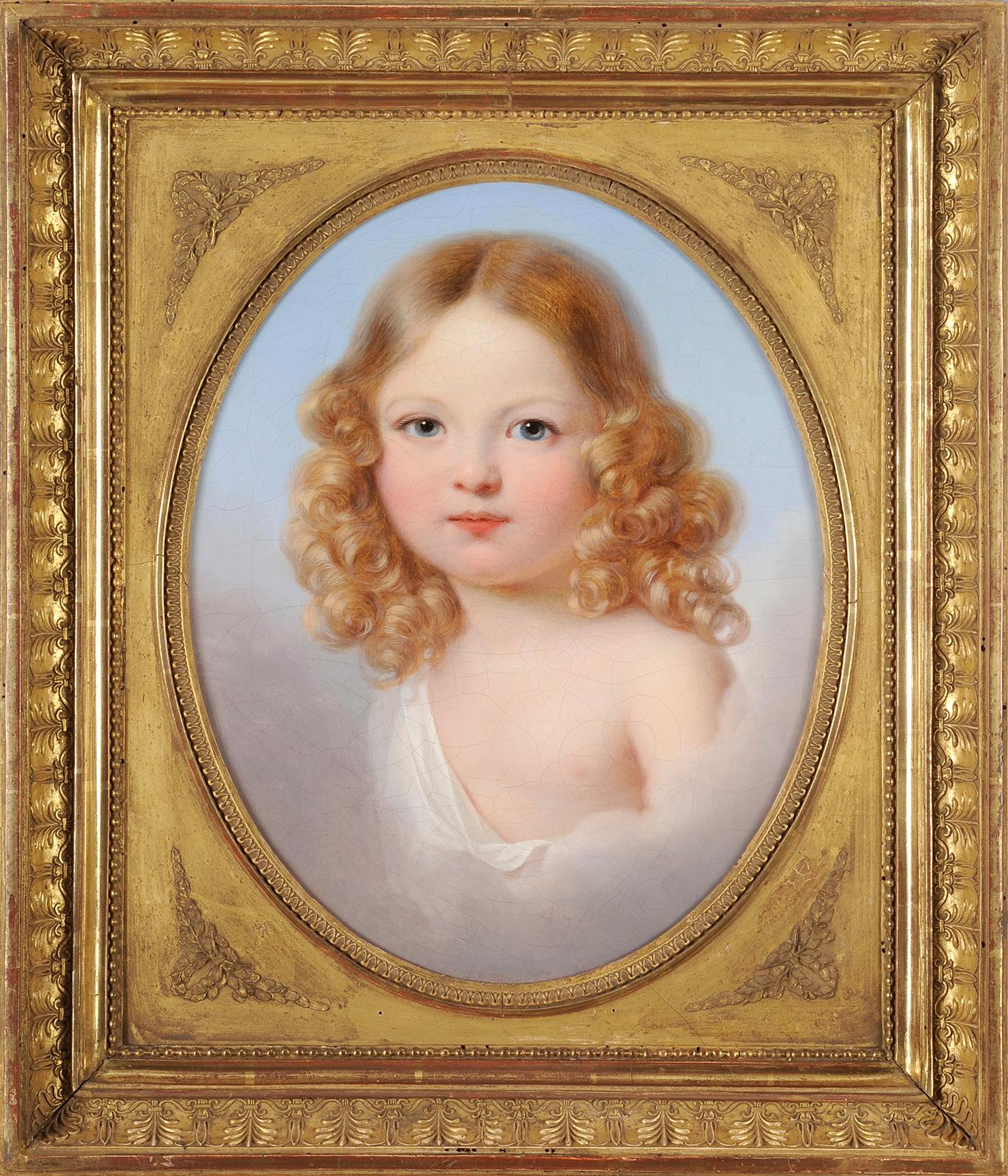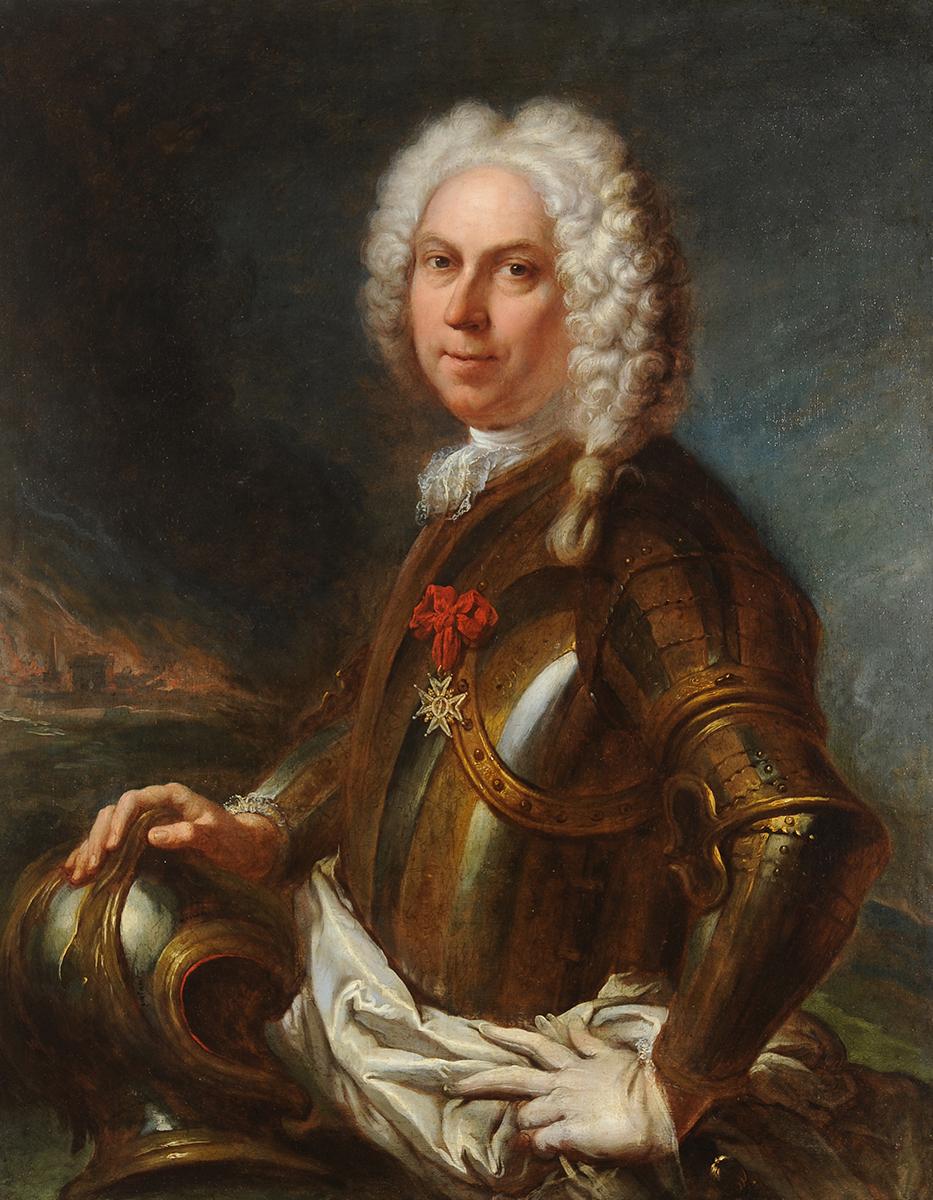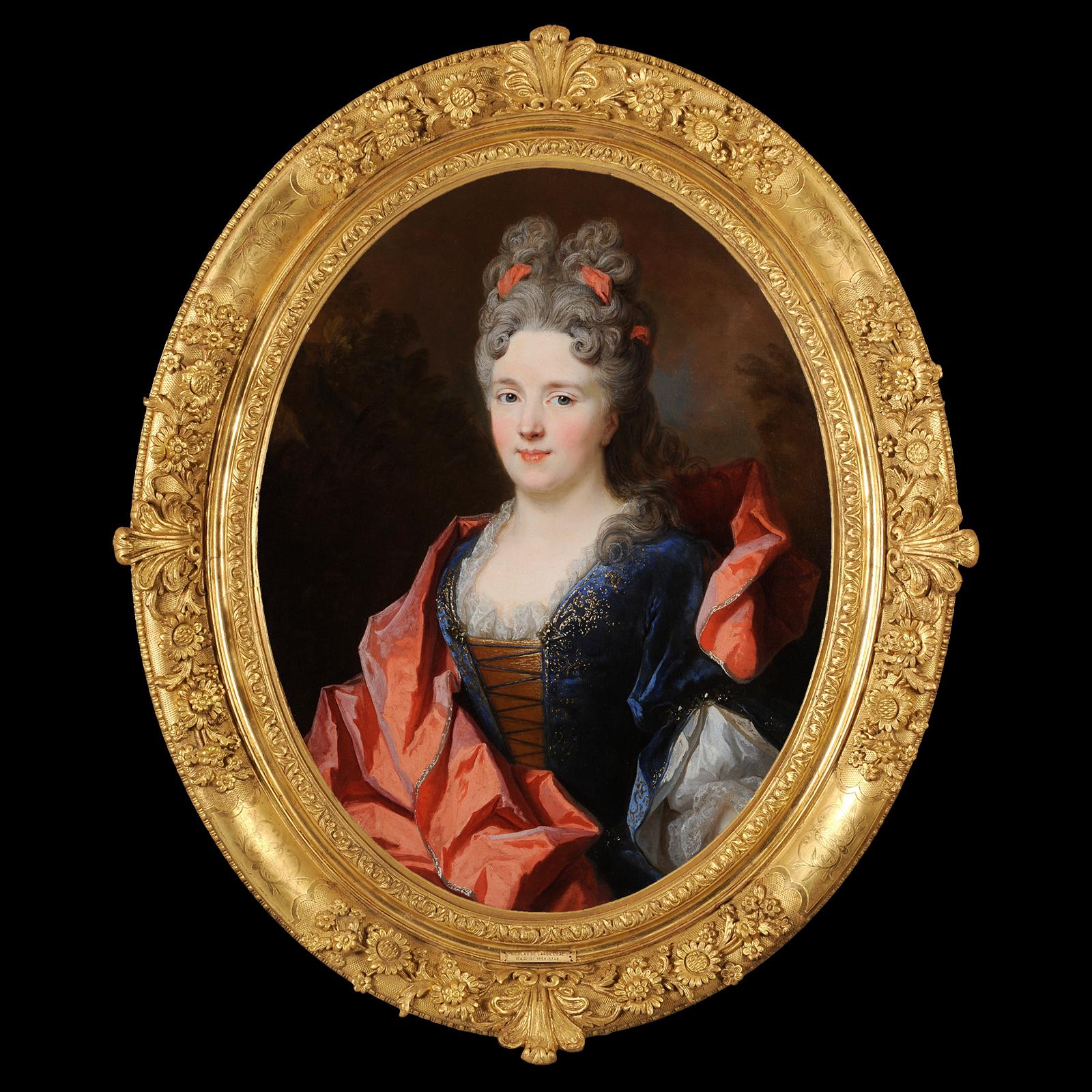Items Similar to Jules Naudin (1817-c.1876) - Tasso arriving at his sister's house in Sorrento
Want more images or videos?
Request additional images or videos from the seller
1 of 12
Attilio ManganaroJules Naudin (1817-c.1876) - Tasso arriving at his sister's house in Sorrento1851
1851
About the Item
Jules Ambroise Francois NAUDIN
(Paris 1817 – c.1876)
Tasso arriving at his sister's house in Sorrento
Oil on canvas
H. 49 cm; L. 37.5 cm
Signed lower right
Exhibition: 1852, Paris Salon, under number 959
Related work: Engraving by Jean-Denis Nargeot in 1852
Bibliography: L’Illustration, April 24, 1852, engraved by Best, Hottelin and Regnier, after a drawing by Valentin) and reproduced p.260, cited p.262; La Mode: Political, Religious and Literary Review, 1852, quoted; Journal des Demoiselles, 1852, engraved by Nargeot and reproduced; Almanac of literature, theater and fine arts, 1853, p.35, quoted.
A pupil of Léon Cogniet, Jules Naudin made his debut at the Paris Salon in 1838 and exhibited there until 1876, the supposed year of his death, mainly portraits and religious or historical subjects. In 1838 and 1841, he competed for the Grand Prix de Rome in painting at the School of Fine Arts and won a Second Grand Prix in 1841.
His wife Henriette Demours gives him a son born in 1853, Charles Edouard, who will move towards sculpture and architecture after training at the Beaux-Arts in Paris. Charles-Edouard bequeathed to the Louvre Museum a series of drawings by his father representing Italians in regional costumes, located on each sheet. This donation testifies to Naudin's travels in Italy and therefore to the stylistic reality of his compositions, of which our canvas is an example.
In 1852, a copy of the painting by David representing Bonaparte crossing the Grand-Saint-Bernard was commissioned from him for the Hospice de Mont Genèvre. A few years later, Christ who covers the poor and orphans with his mantle will be acquired by the State and placed in the Saint Front church in Ribérac (Dordogne), as will The Virgin with the Child Jesus who picks a branch of cypress, which will join the church of Luzarches (Val d'Oise) following the Salon of 1865. Two years later, the State buys him an Ecce Homo, then placed in the chapel of the high school of Clermont-Ferrand.
Our painting must have had some success at the Salon of 1852 since it was engraved twice and published in L'Illustration and the Journal des Demoiselles.
L’Illustration describes it as follows: “This little picture is fairly well composed, and can provide the subject of a pleasant engraving; but there is reason to reproach painting for the equality of the smooth touch and the uniformity of the tint, whatever the variety of the objects, flesh, fabrics or terrain.
The critical article on the 1852 Salon of L’Almanach de la Littérature, du Théâtre et des Beaux-Arts distinguishes our work, in the category of genre paintings, as one of those “having received the votes of the connoisseur public”.
Similarly, our painting stood out in the article on the Salon published in the July 5, 1852 issue of La Mode: political, religious and literary review: "We have cleared this inextricable mess of mediocrity from a painting by M. Jules Naudin, who has qualities…”, being part of “… those which seemed to us the most deserving of being pointed out to public scrutiny”.
Our work represents the moment when, in 1577, the famous Italian poet Torquato Tasso known as Le Tasse (born in Sorrento in 1544), while he was imprisoned in Ferrara by the Este family following an incident, escaped and comes to join his sister Cornélia living in Sorrento in November. Welcomed with kindness, he stayed with her for some time, but decided to go to Rome at the end of January 1578.
The incredible life of Tasso will be illustrated by many artists in the 19th century, between 1810 and 1870, in history painting in France, at a time when his work is experiencing a resurgence of interest: Menjaud, Franquelin, Fleury Richard, Dejuinne, Larivière, Clérian, Achille Deveria, Granet, Louis Gallait, Eugène Delacroix…
As for our subject in particular, it is treated for the first time by Louis Ducis in 1812 (the painting will be bought by the Empress Joséphine), within a cycle devoted to Tasso, then by Alfred de Curzon in 1859 (quoted above top) or even by Nicaise de Kayser (Cornilliet drew an engraving from it exhibited at the Salon of 1863).
The booklet of the Salon of 1812 captioned Ducis' painting thus: “On returning home, he announced himself as a messenger who brought her news of his brother. His sister did not recognize him; she opened the letter in which the unfortunate Torquato represented himself in the most cruel position. The tender Cornélia, on reading this frightful news, testified to such deep pain that Tasso could not bear his disguise and hastened to console her by throwing himself into her arms.
In 1859, Curzon's painting is described as follows: "Misled by his sickly imagination, he had fled from Ferrara. He arrives at his sister's, disguised as a shepherd and presents her with a letter in which he says he is in the greatest danger. From pain, Cornélie will faint. Tasso throws off his coat, makes himself known and holds her in his arms.
- Creator:Attilio Manganaro (1865 - 1890, Italian)
- Creation Year:1851
- Dimensions:Height: 19.3 in (49 cm)Width: 14.77 in (37.5 cm)
- Medium:
- Movement & Style:
- Period:
- Condition:Perfect condition. Cleaned.
- Gallery Location:BELEYMAS, FR
- Reference Number:1stDibs: LU186029879742
About the Seller
No Reviews Yet
Vetted Seller
These experienced sellers undergo a comprehensive evaluation by our team of in-house experts.
Established in 2011
1stDibs seller since 2022
- ShippingRetrieving quote...Ships From: BELEYMAS, France
- Return PolicyThis item cannot be returned.
More From This SellerView All
- Young woman portrait with a white bowLocated in BELEYMAS, FRCharles HERMANN-LÉON (born Léon Charles Sigismond HEMRMANN) (Le Havre 1838 - Paris 1908) Portrait of a young woman Oil on canvas H. 54 cm; L. 41 cm Signed and dated upper right - 187...Category
1870s French School Figurative Paintings
MaterialsOil, Canvas
- Presumed portrait of Baron de VennacLocated in BELEYMAS, FRMarianne LOIR (Paris 1705 – Paris 1783) Presumed portrait of Jean-Jacques-Blaise Baloin de Belvèse, Baron de Vennac (?-1781) Oil on oval canvas H. 54.5 cm; W. 46 cm (around 90 cm hig...Category
1770s French School Figurative Paintings
MaterialsOil, Canvas
- Portrait of singer Adelina Patti - L. Frossard - OperaLocated in BELEYMAS, FRL. FROSSARD (active in Vienna around 1870) Portrait of Adelina Patti (1843-1919) Oil on canvas H. 100.5 cm; L. 73.5 c Signed lower left If the artist maintains a certain discretion ...Category
1860s French School Figurative Paintings
MaterialsCanvas, Oil
- Child portrait in cloudsLocated in BELEYMAS, FRFrench school circa 1800 Portrait of a child in the clouds H. 40 cm; L. 32 cm This luminous portrait is that of a child of three or four years old, represented in the clouds. The ve...Category
Early 1800s French School Figurative Paintings
MaterialsOil, Canvas
- Portrait of a man in armorLocated in BELEYMAS, FRAttributed to Jacques DUMONT aka DUMONT LE ROMAIN (Paris 1701 - 1781) Presumed portrait of Louis-Joseph de Formanoir (?-1732) Oil on canvas H. 91.5 cm; ...Category
1750s French School Figurative Paintings
MaterialsCanvas, Oil
- Presumed portrait of Princess de Conti, Marie-Anne de BourbonBy Nicolas de LargillièreLocated in BELEYMAS, FRNicolas de LARGILLIERRE (Paris 1656 – 1746) Portrait of a woman, presumed to be Marie-Anne de Bourbon, Princess of Conti (1666-1739) Oil on oval canvas H. 80 cm; L. 61 cm (107 x 91 c...Category
1730s French School Figurative Paintings
MaterialsOil, Canvas
You May Also Like
- MUSKETEERS - French School - Figurative - Italian Oil on Canvas PaintingBy Eugenio De BlasiLocated in Napoli, ITMusketeers - Oil on canvas cm.90x80, Italia, 2006, Eugenio De Blasi (3c59a) Eugenio De Blasi's painting is inspired by the neoclassical genre of the French painter Alex De Andreis who portrays his favorite subjects The Musketeers...Category
Early 2000s French School Portrait Paintings
MaterialsOil, Canvas
- SPRING BEAUTY - Angelo Granati - Oirtrair of Oil on Canvas PaintingBy Angelo GranatiLocated in Napoli, ITSPRING BEAUTY - Oil on canvas painting by Angelo Granati, Italy 2011 Gold leaf gilded, pleated silk and mirror wooden frame ext. mis. cm. 164x106. This is his reinterpretation of pa...Category
2010s French School Figurative Paintings
MaterialsCanvas, Oil
- Souvenir from Italy: Pifferaro playing the zampogna with the familyLocated in PARIS, FRJoseph BEAUME (Marseille, 1796 – Paris, 1885) Souvenir from Italy: pifferaro playing the zampogna with the family Oil on canvas Signed lower left 73.5 x 60 cm Provenance: probably...Category
Mid-19th Century French School Figurative Paintings
MaterialsOil
- Portrait of a child with blue eyesBy Charles Zacharie LandelleLocated in PARIS, FRCharles Zacharie LANDELLE (Laval, 1821 – Chennevières/Marne, 1908) Portrait of a child with blue eyes Oil on canvas Monogrammed and dated lower l...Category
Mid-19th Century French School Portrait Paintings
MaterialsOil
- The death of General Négrier on Place de la Bastille, Paris - FranceBy Nicolas Edward GabéLocated in PARIS, FRNicolas Edward GABE (Paris, 1814 - Paris, 1865) The death of General Négrier on Place de la Bastille on June 25, 1848 Oil on canvas Signed and dated lower right 82 x 101 cm 1849 Nicolas Edward Gabé is a 19th century artist who is still little studied to this day and yet seems to have enjoyed, according to the artistic press of the time, a certain notoriety, in particular for his seascapes. The few bibliographical elements that we have come from the Salon booklets and tell us that the artist was born in Paris in 1814, therefore shortly before the end of the Empire. No elements on his artistic training are mentioned in the booklets, we just know that Gabé exhibited at the Paris Salon from 1835 to 1864 where he first practiced miniature then then approached easel painting, risking himself as well in still life that the seascapes, the landscape, the portrait or the hunting. According to press articles, he also took part in various exhibitions in the provinces such as Boulogne-sur-Mer and Marseille. Notably, Gabé did not exhibit at the Salon his large historical canvases on the revolution of 1848, which today are of obvious documentary and iconographic interest; probably for political reasons which are easily understandable to us today in view of the historical events of then. Gabé died in Paris at the age of 51 on January 4, 1865 with a mention in the January 7, 1865 edition of L'Union des Arts: “The death of Mr. Gabé, painter, well known in the export trade in paintings as well as to the auctioneers' hotel, whose sales it supplied through its numerous navies. “ "On June 25, 1848, in front of the barricades erected in the Bastille by the insurgents of the Red Republic, General Négrier fell to death, while he was uttering words of order and conciliation". Here are the opening lines of the tribute paid by Colonel Borgarelli d´Ison, friend of General Négrier. General Négrier belonged to a family from Maine, brought back by Marshal Lannes from emigration. Born in Le Mans on April 27, 1788, François Marie Casimir de Négrier entered, barely 18, as a volunteer in the 2nd Light Infantry Regiment. He began in 1806 with the campaigns of Prussia and Poland, during which he earned, through his bravery, the rank of sergeant and the decoration of the Legion of Honor. He made the following campaigns in Spain and Portugal, and left, with his regiment, only for the campaign of France, in 1814, after having risen successively, by actions of brilliance and by a serious wound, to the ranks of head of battalion and officer of the Legion of Honor, with which he was provided from October 1813. The Restoration retained his rank in his regiment. After having fought and wounded a second time seriously in Waterloo, Négrier was recalled in 1816 under the second Restoration. He was appointed, in 1825, lieutenant-colonel, then colonel in 1830, brigadier general in 1836, and of division in 1841. From March 1837 he participated in the conquest of Algeria. The Revolution of 1848 found Negrier in possession of the important command of the 16th Military Division in Lille. Quaestor of the Assembly in these times which promised to be troubled, Négrier reviewed the Place de la Concorde on June 23 at around noon various mobile guard battalions. He then took the head of 2,000 men provided by the 10th and 11th legions of the national guard and bivouacked on the Place du Palais until the next day 24. On Sunday 25 at nine o'clock, the Négrier division resumed the fight towards the Saint suburb. -Antoine. The troop gains continual advantages. At around two o'clock the column of Négrier had seized the Pont Marie: it had removed the barricades from the Quai Saint-Paul, the rue de l'Etoile, the rue des Barres...Category
Mid-19th Century French School Figurative Paintings
MaterialsOil
- Blue macaw perched on a branchBy Jean-Baptiste OudryLocated in PARIS, FRFrench school of the second half of the 19th century, follower of Oudry Blue macaw perched on a branch Oil on canvas 73 x 60 cmCategory
Late 19th Century French School Portrait Paintings
MaterialsOil
Recently Viewed
View AllMore Ways To Browse
Brother Sister
Sister And Brothers
The Little Sisters
P 35
Buy Antique Art
1851 Exhibition
Italian School Engraving
1876 Portrait
Antique Letter C
Top Artists Oil C
Eugene C
Vote Paintings
Kayser Used
Mantle Painting
French 19th Century Architectural Drawings
Bonaparte Painting
Coat Of Arms Painting
Virgin Child Painting
